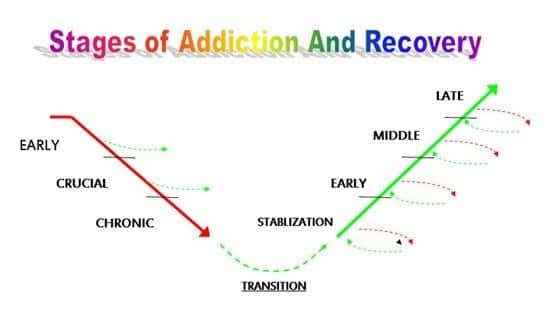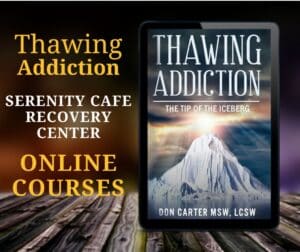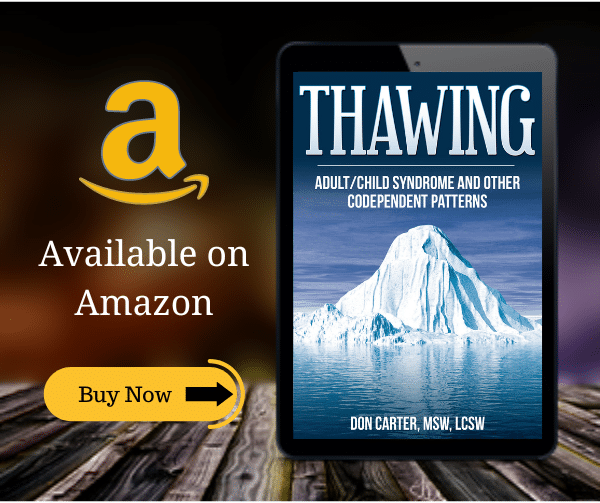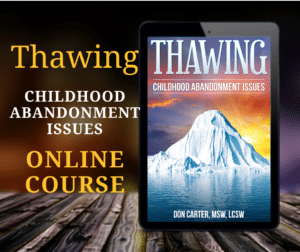
Grief and Addiction are Interconnected
Grief and Addiction Video
Today we’re going to take a look at grief and addiction. I want to start with a diagram called the Feelings Chart (see below) which was created by Vernon Johnson of the Johnson Institute back in the early 1960s. The Feelings Chart represents the full range of human emotions from the most amount of pain that one Can feel to the most euphoria or bliss one can feel. The middle section of the chart represents the area where we typically spend about 80% of our lives.

When we encounter a blessing or other important milestones such as a wedding or a birth or new job we moved toward you for a kind of the scale, maybe spend a few days or few weeks or even a few months there. When we encounter a loss or something bad happens such as the death in the family, a divorce, or loss of a job, then we gravitate towards the painful end of the chart and maybe spend a few weeks or months are you even a year or so there. At least that’s how it supposed to work. But in the stages of the development of a relationship with an addiction, we take Mother Nature for granted and as we shall see this can only cause problems.
My preferred definition for addiction is by Craig Nakaan who says that addiction is an unhealthy relationship with an object or activity in order to produce the desired mood swing. There four stages in the development of this unhealthy relationship or attachment to an object such as alcohol or food, or to an event such a sex or gambling.
- Learning the mood swing
- Seeking the mood swing
- Harmful dependence
- Using to Feel Normal, AKA Using to Function
Learning the Mood Swing
For the purpose is of this presentation we will use the addiction of alcoholism as our subject. Keep in mind that generally speaking these dynamics relate to any form of unhealthy attachment to an object or activity, i.e., addiction. In the first stage, Learning the Mood Swing, we are usually teenagers sometimes even younger when we take that first drink. And if alcohol is what “really does it” for us then its the drug of choice because we love what it does for me — moves me toward the euphoric end of the scale.(see below) This is usually a very powerful lesson because in this stage we discovered that we are no longer subject of the whims and moods of life. Now if we know like how we feel, we can automatically change that feeling with a drink or drug. And in the early stage we usually we also discover that after the euphoria or bliss wears off, we return right back to normal.

So, frequently in the early stages of this attachment that we form there are little or no harmful consequences which makes it in even more powerful experience. We all want to have power over life… we all want to have power over our emotions, to change how we feel whenever we want to. Teenagers are especially prone to this temptation.
Seeking the Mood Swing
In stage two of the development of this unhealthy attachment, we actually begin using this new power to change how we feel — purposefully. For example, we may start out at the lower end of the scale and remember that all we have to do is take a drink or smoke a joint in order to move toward the euphoric end of the scale.(see below) And since we are still in the early stages of this relationship, we experience a double reinforcer. Not only do we move from the painful end of the scale poor to the euphoric end, but we may also find that we end up back at normal, feeling better than we did in the beginning of this experience…

Harmful Dependence
In stage three, Harmful Dependence, we now begin to experience the negative consequences while we’re drinking. In other words, we do our normal thing and take a drink to move toward euphoria, then while we are intoxicated something bad happens. Maybe we get a DWI, or lose our relationship, or spend too much money. The negative consequence will send us back toward the negative into the scale like a slingshot. (see below) By itself, this is not enough to constitute an addiction. If I have one or two negative consequences, then decide I’m drinking too much or drinking irresponsibly and I never do it again, then it’s not an addiction. But continued use despite serious negative consequences is a sign of big problems…

We enter Harmful Dependence when we begin to defend and rationalize our ability to drink normally, even in the face of multiple negative experiences. For example, I might say to myself that “I should have eaten something before I went out last night. I wouldn’t have gotten so drunk.” Or something like “Bill mixed the drinks to stiff last night I’m going to have to stay away from his house now from now on.” Or perhaps I switch from whiskey to beer saying “Whiskey’s just not good for me.”
In other words, I begin to rationalize to avoid facing my problem with alcohol. Denial indicates that unconsciously I am unwilling to accept that I cannot drink normally because I’m dependent on alcohol. I may be physically dependent meaning that my body has adjusted to the presence of alcohol on the cellular level, or psychologically dependent in that I use alcohol to cope with my feelings. Or I eventually progress to both physically and psychologically dependent.
To know consciously than I am dependent on a chemical or an activity is not comfortable for me, so my subconscious mind prevents my conscious mind from knowing that by applying defense mechanisms such as rationalization, minimization, blaming or projecting, and disarming just to name a few. And the more problems I have, the more exercise I give my defense mechanisms. And the more I practice, the better I get it at defending my ability to drink in the face of overwhelming evidence it’s not good for me. This is why with an addiction our defense mechanisms can become honed to perfection so that we become victims of our own defenses.
Using to Feel Normal
In the fourth stage, Using to Feel Normal or Using Just to Function, we can begin to see the wall of defenses we built around all of those negative consequences that accumulate as a result of our addiction. We can also begin to see how the trap is set. In the 4th stage, we spend most of our time in the negative end of the Feelings Chart, the painful end. At this point, we practice our addiction in order to move toward euphoria again but in this stage, we are lucky to even achieve any sense of normalcy. And when that wears off, we return right back to the painful end of the scale. (see below)

It is in this fourth stage that it becomes easy to see an addiction because everything is so obvious…
- loss of control,
- obsession,
- loss of social support, even family members give up on us,
- physical deterioration,
- severe problems in major life areas, such as work, relationships, or emotions
- The collapse of the alibi system
And even with all this denial is strong enough to allow the alcoholic to continue to rationalize away his disease and continue to drink. At this point the drinking is not about feeling good, it’s about survival. There are two kinds of pain to be faced in this stage of development. The first is a physical withdrawal and the second is the psychological withdrawal. It’s a double-edged sword. Now by allowing us to continue to drink in the face of overwhelming evidence that it’s bad for us, our defenses are working to protect us from the pain of withdrawal whether it’s physical or psychological or both.
The Grief Process
Now we want to switch gears for a moment and talk about the grief process. Sooner or later in life, we all come in contact with grief and loss. Grief is a healthy process that allows us to let go of things that we lose, especially things that are important to us. In order to understand the grief, we need to understand what a love object is. A love object is anything that becomes important to us whether it’s a person, a car, a job, maybe even a way that we look at ourselves. when something becomes important to us we attached to it on an emotional level. This attachment is like a rope or a cable in that when we first attach to it, we have only a few stands of the attachment. But as we send out more strands, that attachment gets stronger and stronger over the years.
Grief helps us break that bond. If you have ever seen a rope of cable break, you know it doesn’t just snap. It frays around the edges and then when it gets to the core strands, it snaps. Grief is this unraveling and letting go process.
The Stages of Grief
- Denial
- Anger/Guilt
- Bargaining
- Depression
- Acceptance
Stage one of the grief process is Denial. The final stage of the grief process is acceptance. Denial is considered a shock absorber for the soul because, as already mentioned, it allows the reality of a loss to sink and slowly at the persons own pace. You may have experienced the denial of a loss when you first heard about it and “went numb”. Or maybe you have seen someone who just discovered they lost their loved one but act as if nothing is wrong. The emotional awareness doesn’t quite settle in until the defense mechanisms allow it to do so. So in certain contexts, denial has a useful purpose too. Denial is only a problem when we get stuck there.
Stage two is the Anger/Guilt stage of grief. At this stage, we take one step closer to acceptance of the loss and we don’t like it! We may get angry at the object of our loss, at ourselves (in which case it would be guilt), or we may get angry at the man on the street (if that’s all that’s available.) We may even get angry at God for allowing us to lose this very important love object.
Bargaining is the third stage of grief. We move even closer to acceptance when we begin using “if-then statements” to figure out ways to avoid the loss altogether. For example, a person might say “if we get counseling then maybe we don’t have to get a divorce” , or “if I go to treatment then they will teach me to drink responsibly”. So we can see here that sometimes bargaining can be helpful and other times it can be damaging. The good news is we have moved one step closer to the acceptance of the Loss.
Grief-Related Depression is stage four. Another word for it is Mourning. This is where we give testimony to the importance of the loss. If we could just go on without any feelings after losing something important to us, just blowing it off, that might not speak too highly of the attachments that we form. Human beings need to demonstrate the importance of a broken love attachment by going through this grief process. The fourth stage is the most painful stage. Remember, a rope or cable doesn’t just snap. It frays around the edges, comes unraveled and then it snaps. Stage four comes right before the snap at the core of the attachment breaks so that we can let go and move on.
Acceptance is the final stage of the grief process. This may not be a place of peace and joy but it is definitely a place where we can begin to experience the absence of pain when we think about the object of our loss. There is one significant difference between the final stage of grief and all of the other stages. In the first four stages, there are not really very clear-cut boundaries in the process. We can get stuck, or jump back and forth from one stage to another. Or we can be in two or three stages at the same time. But when we reach the acceptance stage, we have completed the process of grief and a broken that love attachment while retaining the good memories and a sense of fondness in our heart.
Summing Up Grief and Addiction
Now I know at least some of you are asking why we are pairing up the Feelings Chart with the Grief Process. It’s a good question. The answer is that grief an addiction go hand-in-hand together. One correlation is as we’ve seen earlier: When we experience the stages of developing an unhealthy relationship with an object or event, we encounter negative consequences. Those consequences cost us something. They may cost us money, relationships, status, opportunities, self-esteem, and many other things that are very important to us. So, during the course of our addition, since we don’t allow ourselves to feel our emotions, we accumulate multiple instances of unfinished grief. These unprocessed instances of loss are just waiting for us on the day that we get sober!
On top of all those losses and all those episodes of unfinished grief, we will need to grieve the attachment to the addiction itself. Because, remember, addiction is an unhealthy primary relationship with an object or event that produces the desired mood swing. The word primary means that has become very important to us. The word relationship signifies the attachment between us and the object of our addiction. Its a love and trust attachment.
Still, further, we will need to grieve the loss of all those things that we associated with that relationship with our addiction, such as playmates, play places, and playthings. There may have been a lot of attachments to people, places, and things that would allow us to continue to practice our addiction without hassles — people just like us.
And then there is the “unhealthy love and trust attachment to an object or activity” that we will need to grieve as well! Many people say “not me! I say good riddance!” But they are not considering how that relationship with their addiction has woven its way into every area of life.” As we can see the initial stages of recovery can be difficult without help, especially when we have a lot of emotional wreckage to clean up. This is why many of us need treatment or 90 meetings in 90 days. We need to saturate ourselves in the recovery process in order to be able to learn how to let go and learn how to feel our feelings.
The good news is that all of these losses provide us with an excellent exercise for learning how to live life with healthy emotional coping skills. It also provides us with the motivation to seek Comfort and relief from a power greater than ourselves, and a group of people was going through the same things. Remember the promise in the Beatitude “Blessed are THOSE WHO MOURN for they SHALL BE COMFORTED.” Staying stuck in denial is a refusal to mourn which leaves us without comfort! It is only through facing our grief and loss that we can be truly comforted and find peace.
One more interesting connection between grief and addiction is the curve of the diagrams of both processes. Take a look at the image of the Stages of Recovery and Addiction below, and compare that with the diagram of the grief process in the video above!





